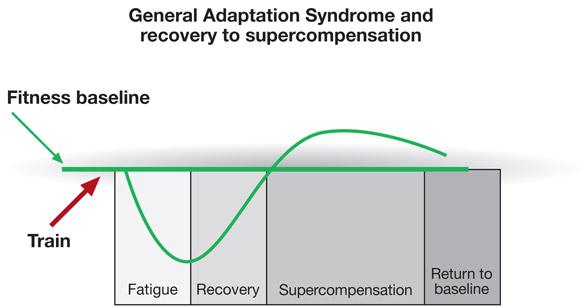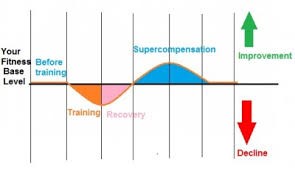WHAT IS THE MUSCULAR SUPER COMPENSATION CONCEPT
The muscular super compensation concept is one of the most important concepts to understand in the field of exercise and muscular and athletic development.
First, the muscular compensation concept outlines how and when our muscles react to and recover from a training bout. Then it outlines how and when our muscles “super compensate” their abilities (think strength and endurance) beyond the point at which they existed before the initial training bout.
WHY UNDERSTANDING THE MUSCULAR SUPERCOMPENSATION CONCEPT IS IMPORTANT
Understanding how and when our muscles react, recover, and super compensate from one workout to the next enables us to schedule our workouts so that we maximize our muscular and athletic development and minimize our risk of over training and injury.
A VISUAL REPRESENTATION OF THE MUSCULAR SUPER COMPENSATION CONCEPT
Here is a chart that puts the muscular super compensation concept into visual terms.

The vertical axis represents our muscles’ abilities (strength and endurance) and the horizontal axis represents time. The green straight line near the top running from left to right represents our muscles’ abilities before the workout tracked by this chart (labeled “Train.”) The green wavy line that runs from left to right that drops down, raises back up, and then begins to drop back down again represents our muscles’ abilities in the hours and days after the workout tracked by this chart.
INTERPRETING THE SUPER COMPENSATION CHART
Looking at the chart above we see there are three distinct phases our muscles pass through as they react to, recover from, and super compensate from a workout.
First is the fatigue phase. The fatigue phase begins right after our workout finishes and last until our muscle begins to recover. During the fatigue phase our muscles’ abilities (remember think strength and endurance) are reduced compared to their pre workout level. This because our muscles have been physically damaged from the workout. (Which is completely normal.)
Next is the recovery phase. Once our muscles have reached the end of the fatigue phase and begin to repair themselves we enter the recovery phase. During the recovery phase, our muscles’ are still damaged from the previous workout and their abilities are still diminished compared to their pre workout abilities, but they are now beginning to recover, repair, and regain their pre workout abilities.
The third phase is the super compensation phase. The point on the chart at which our post workout muscular abilities, represented by the wavy line, return to their pre workout level, represented by the straight line, marks the end of the recovery phase and the beginning of the super compensation phase.
By the super compensation phase our muscles have fully repaired, are fully healed, and have fully regained their pre workout capabilities. What defines the super compensation phase is that during this phase our muscular performance capabilities are now greater than they were before our last workout.
However, this elevated performance capability won’t last. As we see in the chart below, after a period of time the wavy line (actually orange in the chart below) begins to dip back down toward our original ability level and will come to rest right back on the line representing our original performance capabilities.

APPLYING THE MUSCULAR SUPER COMPENSATION MODEL
Okay, now that we understand what the muscular super compensation model is, why it is important, and we can visualize it, lets learn how to apply it. Click here for Part II of this piece to see how to apply the muscular super compensation model to maximize muscular and athletic development.




